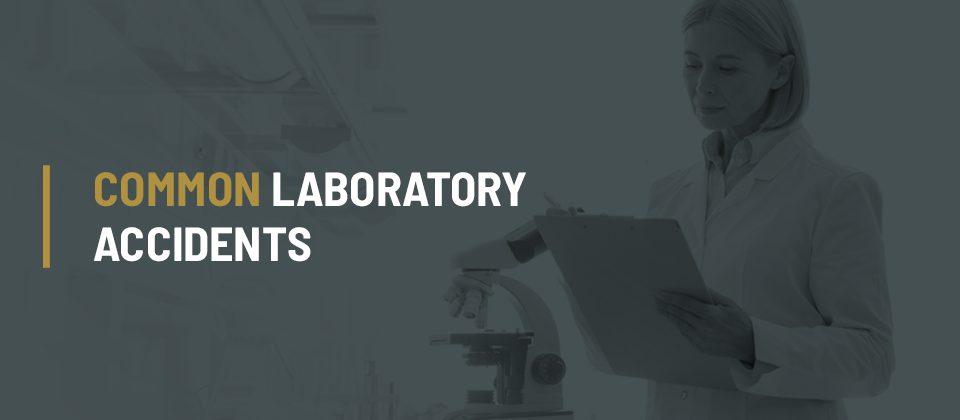Table of Contents
Updated on 06/17/2024

From corporate chemical companies to medical labs to educational settings, lab accident statistics show that safety concerns and unfortunate incidents in laboratories are entirely too common. Even if many lab workers feel safe in the laboratory, close examination can reveal some form of negligence on the part of a supervisor or employer. Lack of training can lead to unwitting engagement in unsafe practices.
The chemical industry and other laboratory positions are also rife with unnecessary exposure to unreasonable dangers. Even if lab workers strictly follow safety protocols in a laboratory setting, accidents can still occur, resulting in serious injuries. Most of the time, an accident is just that — an accident. Yet, it’s essential to look in-depth at the cause of injury.
The Dangers of Working in a Laboratory Setting
Multiple industries utilize laboratory settings, including health, petrochemical, manufacturing, science and education. These facilities supply controlled conditions for exploring essential medical, scientific and technological solutions.
Sadly, serious accidents and subsequent injuries are too frequent. Workers face many hazards in the laboratory environment, and employers must provide reasonable lab safety measures to protect their employees. Part of the problem might be that workers feel safer than they truly are in the laboratory setting. Another factor is the lack of proper safety training on handling hazardous materials.
Unfamiliarity with potential dangers leaves workers more susceptible to injury. Here are just some of the risks you may encounter working in a laboratory setting:
Chemical hazards: Handling chemical or toxic substances can cause sensitization, irritation and carcinogenicity.
Biological hazards: Also called biohazards, these biological threats endanger the health of living organisms. This could include potential infection from bloodborne pathogens or biological agents like bacteria and viruses.
Physical hazards: Poor posture, flammable substances and loud noise all fit into the category of physical hazards.
Safety hazards: Any unsafe working conditions that can cause injury or illness is a safety hazard. Examples include broken glass, unbalanced equipment, high-temperature items and electrical risks.
Allergy hazards: In a lab, airborne triggers and skin allergies, such as latex allergies, are more common risks.
Dangers in the laboratory setting can also come from unsafe practices, including:
Working alone in the laboratory.
Neglecting to wear a lab coat.
Lack of safety training.
If a violation of safety protocol or even an honest mistake has caused you to experience a lab-related injury, you should speak with a lab accident injury attorney in Pennsylvania who specializes in workers’ compensation.
7 of the Most Common Laboratory Accidents
Awareness is an important aspect of lab safety. Knowing the seven most common types of lab accidents will help you understand these often-overlooked risks and exercise precautions against potential dangers.
1. Chemicals
Carelessly handling chemicals is like playing with fire and can lead to devastating consequences, such as exposure, reactions and chemical spills. So, if you work in a chemistry lab or another environment with toxic materials, ensure you understand, respect and meticulously follow chemical safety guidelines.
2. Heat
While high temperatures are needed in many labs, extreme heat is one of the most common causes of lab accidents. Heat increases the risk of fire, explosion and over-pressurization, which can lead to serious burns.
3. Cuts and Scrapes
The use of sharp tools is another potential danger in the laboratory setting. Common laboratory tools, like needles and razor blades, can cause scrapes and cuts. If there is a breakage, cleaning up broken glass also poses a potential risk.
4. Contamination
Contamination is when you come into contact with something dangerous or toxic. Even if you protect your skin and clothing with the proper equipment, interactions with any foreign substance can wreak severe consequences.
5. Inhaling Substances
Inhalation is another common laboratory concern. When a space is not adequately ventilated, inhaling chemicals or gases can cause short- and long-term issues, such as headaches, nausea or fainting.
6. Fires
Many laboratories work with flammable materials, making fire a common danger. When not stored or sealed properly, volatile substances can lead to sudden flares and burn-related injuries.
7. Breaks and Spills
Glass and other breakable materials are common in a lab setting. Liquids can spill when a tube, beaker or flask is dropped and breaks. Often, these accidents are caused by negligence, rushing or not following proper procedures. Breaks and spills can lead to cuts and contamination.
What Should You Do If You Experience a Lab Accident in Pennsylvania?
Laboratory workers are responsible for following protocol and keeping the lab environment as safe as possible for all employees. However, the lab itself must follow safety guidelines from the Occupational Safety and Health Administration (OSHA) to ensure safe working conditions.
Employers have a duty to warn lab workers about known and potential dangers that exist in a laboratory. There should always be consistent enforcement of laboratory safety guidelines, including the do’s and don’ts of lab procedures.
You should speak with lab accident injury attorneys in Pennsylvania. They can guide you through a workers’ compensation claim and help determine if employer negligence was present at your place of work. If your employer is violating OSHA standards, you may have a legal case on your hands. Common OSHA violations in the laboratory setting include:
Absence of signs and labels warning of potential hazards
Insufficient protective gear
Lack of protection from heat, energy or electrical sources
Inadequate ventilation when working with chemicals, gases or smoke
Get in Touch With Our Laboratory Accident Attorneys in PA
Have you been injured in a laboratory accident at work? If so, you may be entitled to workers’ compensation in Pennsylvania. Workers in Pennsylvania have 120 days after the date of the injury to apply for workers’ compensation.
At Frommer D’Amico, we represent workers. As lab accident injury lawyers in Pennsylvania, we believe you should receive the benefits you’re entitled to after sustaining a workplace injury. Are your benefits late? Is your employer attempting to modify your benefits? We can help you fight for the benefits you’re owed. We can also guide you if you feel there is undue negligence on the part of your lab supervisor or employer.
If you have questions about your workers’ compensation eligibility or are experiencing trouble receiving your rightful benefits after a lab accident in Pennsylvania, contact us online or call us at 717-400-1405 for a confidential, free consultation.

John Frommer has been litigating Pennsylvania workers’ compensation and personal injury cases for more than 30 years. Since 1997 he has been an Adjunct Instructor of Trial Advocacy at The Dickinson School of Law at Penn State. He was named to the Order of the Barristers and named as a Pennsylvania Super Lawyer for Workers’ Compensation.
Reviewed by John Frommer.


